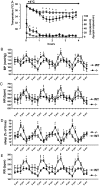Growth retardation and altered autonomic control in mice lacking brain serotonin
- PMID: 19520831
- PMCID: PMC2700938
- DOI: 10.1073/pnas.0810793106
Growth retardation and altered autonomic control in mice lacking brain serotonin
Abstract
Serotonin synthesis in mammals is initiated by 2 distinct tryptophan hydroxylases (TPH), TPH1 and TPH2. By genetically ablating TPH2, we created mice (Tph2(-/-)) that lack serotonin in the central nervous system. Surprisingly, these mice can be born and survive until adulthood. However, depletion of serotonin signaling in the brain leads to growth retardation and 50% lethality in the first 4 weeks of postnatal life. Telemetric monitoring revealed more extended daytime sleep, suppressed respiration, altered body temperature control, and decreased blood pressure (BP) and heart rate (HR) during nighttime in Tph2(-/-) mice. Moreover, Tph2(-/-) females, despite being fertile and producing milk, exhibit impaired maternal care leading to poor survival of their pups. These data confirm that the majority of central serotonin is generated by TPH2. TPH2-derived serotonin is involved in the regulation of behavior and autonomic pathways but is not essential for adult life.
Conflict of interest statement
The authors declare no conflict of interest.
Figures



References
-
- Walther DJ, Bader M. A unique central tryptophan hydroxylase isoform. Biochem Pharmacol. 2003;66:1673–1680. - PubMed
-
- Walther DJ, et al. Synthesis of serotonin by a second tryptophan hydroxylase isoform. Science. 2003;299:76. - PubMed
-
- Walther DJ, et al. Serotonylation of small GTPases is a signal transduction pathway that triggers platelet α-granule release. Cell. 2003;115:851–862. - PubMed
Publication types
MeSH terms
Substances
LinkOut - more resources
Full Text Sources
Other Literature Sources
Medical
Molecular Biology Databases

